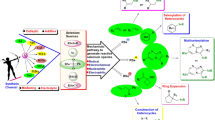Abstract
A series of π conjugated naphthalimide derivatives having an imide group as an acceptor conjugated with a methoxy arylethynyl or a methoxyphenyl triazole as a donor were prepared by Sonogashira coupling or “click” chemistry. Their photophysical properties were investigated by steady state and time resolved fluorescence spectroscopy and modelled by TD-DFT calculations. Compound Naphth-AlkyneOMe has a high fluorescence quantum yield and displays efficient photoinduced charge transfer in solution as well as in the powder state. Compound Naphth-TriazoleOMe exhibits a very high Stokes shift and its fluorescence quantum yield is low, which can be rationalized by theoretical calculations.
Similar content being viewed by others
References
B. Valeur, and I. Leray, Design principles of fluorescent molecular sensors for cation recognition, Coord. Chem. Rev., 2000, 205, 3–40.
M. Fujii, M. Namba, M. Yamaji, and H. Okamoto, Solvent-induced multicolour fluorescence of amino-substituted 2,3-naphthalimides studied by fluorescence and transient absorption measurements, Photochem. Photobiol. Sci., 2016, 15, 842–850.
M. H. Ha-Thi, M. Penhoat, V. Michelet, and I. Leray, Highly selective and sensitive Hg2+ fluorescent sensors based on a phosphane sulfide derivative, Org. Biomol. Chem., 2009, 7, 1665–1673.
A. K. Bandela, S. Bandaru, and C. P. Rao, A Fluorescent 1,3-Diaminonaphthalimide Conjugate of Calix[4]arene for Sensitive and Selective Detection of Trinitrophenol: Spectroscopy, Microscopy, and Computational Studies, and Its Applicability using Cellulose Strips, Chem.–Eur. J., 2015, 21, 13364–13374.
C. Satriano, G. T. Sfrazzetto, M. E. Amato, F. P. Ballistreri, A. Copani, M. L. Giuffrida, G. Grasso, A. Pappalardo, E. Rizzarelli, G. A. Tomaselli, and R. M. Toscano, A ratiometric naphthalimide sensor for live cell imaging of copper(I), Chem. Commun., 2013, 49, 5565–5567.
J. Wang, L. Yang, C. Hou, and H. Cao, A new N-imidazolyl-1,8-naphthalimide based fluorescence sensor for fluoride detection, Org. Biomol. Chem., 2012, 10, 6271–6274.
S. S. Bag, R. Kundu, and M. Das, Click-reagent version of Sonogashira coupling protocol to conjugated fluorescent alkynes with no or reduced homocoupling, J. Org. Chem., 2011, 76, 2332–2337.
S. S. Bag, M. K. Pradhan, R. Kundu, and S. Jana, Highly solvatochromic fluorescent naphthalimides: design, synthesis, photophysical properties and fluorescence switch-on sensing of ct-DNA, Bioorg. Med. Chem. Lett., 2013, 23, 96–101.
X. Li, Y. Lin, Q. Wang, Y. Yuan, H. Zhang, and X. Qian, The novel anti-tumor agents of 4-triazol-1,8-naphthalimides: synthesis, cytotoxicity, DNA intercalation and photocleavage, Eur. J. Med. Chem., 2011, 46, 1274–1279.
M. Sawa, T. L. Hsu, T. Itoh, M. Sugiyama, S. R. Hanson, P. K. Vogt, and C. H. Wong, Glycoproteomic probes for fluorescent imaging of fucosylated glycans in vivo, Proc. Natl. Acad. Sci. U. S. A., 2006, 103, 12371–12376.
S. Ast, S. Kuke, P. J. Rutledge, and M. H. Todd, Using Click Chemistry to Tune the Properties and the Fluorescence Response Mechanism of Structurally Similar Probes for Metal Ions, Eur. J. Inorg. Chem., 2015, 2015, 58–66.
M. S. Alexiou, V. Tychopoulos, S. Ghorbanian, J. H. P. Tyman, R. G. Brown, and P. I. Brittain, The UV–visible absorption and fluorescence of some substituted 1,8-naphthalimides and naphthalic anhydrides, J. Chem. Soc., Perkin Trans. 2, 1990, 837–842.
J. N. Demas, and G. A. Crosby, Measurement of Photoluminescence Quantum Yields–Review, J. Phys. Chem., 1971, 75, 991–1024.
C. Katan, P. Savel, B. M. Wong, T. Roisnel, V. Dorcet, J. L. Fillaut, and D. Jacquemin, Absorption and fluorescence signatures of 1,2,3-triazole based regioisomers: challenging compounds for TD-DFT, Phys. Chem. Chem. Phys., 2014, 16, 9064–9073.
R. L. Martin, Natural transition orbitals, J. Chem. Phys., 2003, 118, 4775–4777.
V. Alain-Rizzo, D. Drouin-Kucma, C. Rouxel, I. Samb, J. Bell, P. Y. Toullec, V. Michelet, I. Leray, and M. Blanchard-Desce, Synthesis, Photophysical, and Two-Photon Absorption Properties of Elongated Phosphane Oxide and Sulfide Derivatives, Chem.–Asian J., 2011, 6, 1080–1091.
S. Ast, T. Fischer, H. Muller, W. Mickler, M. Schwichtenberg, K. Rurack, and H. J. Holdt, Integration of the 1,2,3-triazole “click” motif as a potent signalling element in metal ion responsive fluorescent probes, Chem.–Eur. J., 2013, 19, 2990–3005.
P. D. Zoon, I. H. M. van Stokkum, M. Parent, O. Mongin, M. Blanchard-Desce, and A. M. Brouwer, Fast photo-processes in triazole-based push-pull systems, Phys. Chem. Chem. Phys., 2010, 12, 2706–2715.
A.-S. Cornec, C. Baudequin, C. Fiol-Petit, N. Plé, G. Dupas, and Y. Ramondenc, One “Click” to Access Push-Triazole-Pull Fluorophores Incorporating a Pyrimidine Moiety: Structure-Photophysical Properties Relationships, Eur. J. Org. Chem., 2013, 1908–1915.
N. Mataga, Y. Kaifu, and M. Koizumi, The Solvent Effect on Fluorescence Spectrum - Change of Solute-Solvent Interaction during the Lifetime of Excited Solute Molecule, Bull. Chem. Soc. Jpn., 1955, 28, 690–691.
E. Z. Lippert, Dipolmoment und Elektronenstruktur von angeregten Molekülen, Z. Naturforsch., A: Astrophys. Phys. Phys. Chem., 1955, 10, 541–545.
X. Cao, L. Meng, Z. Li, Y. Mao, H. Lan, L. Chen, Y. Fan, and T. Yi, Large red-shifted fluorescent emission via intermolecular pi-pi stacking in 4-ethynyl-1,8-naphthalimide- based supramolecular assemblies, Langmuir., 2014, 30, 11753–11760.
S. Mukherjee, and P. Thilagar, Insights into the AIEE of 1,8 naphthalimides (NPIs): inverse effects of intermolecular interactions in solution and aggregates, Chem.–Eur. J., 2014, 20, 8012–8023.
Acknowledgments
We gratefully thank Dr Gilles Clavier for fruitful discussions and advice on DFT calculations, and Arnaud Brosseau for his help with transient absorption measurements.
Author information
Authors and Affiliations
Corresponding author
Rights and permissions
About this article
Cite this article
Rémy, C., Allain, C. & Leray, I. Synthesis and photophysical properties of extended π conjugated naphthalimides. Photochem Photobiol Sci 16, 539–546 (2017). https://doi.org/10.1039/c6pp00372a
Received:
Accepted:
Published:
Issue Date:
DOI: https://doi.org/10.1039/c6pp00372a




